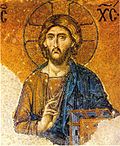- Monophysitism
-
Part of a series on Eastern Christianity 
History Orthodox Church History
Specific regions:
Byzantine Empire
Ecumenical council
Christianization of Bulgaria
Christianization of Kievan Rus'
East-West Schism
Asian Christianity
Coptic Egypt · UkraineTraditions Orthodox Church
Others:
Oriental Orthodoxy
Ethiopian Tewahedo Church
Coptic Church
Church of the East
Eastern Catholic Churches
Syriac ChristianityLiturgy and worship Sign of the cross
Divine Liturgy
Iconography
Asceticism
OmophorionTheology Hesychasm · Icon
Apophaticism
Filioque clause
Miaphysitism
Monophysitism
Diophysitism
Nestorianism
Theosis · Theoria
Phronema · Philokalia
Praxis · Theotokos
Hypostasis · Ousia
Essence vs. Energies
MetousiosisMonophysitism (
 /məˈnɒfɨsaɪtɨzəm/ or /məˈnɒfɨsɪtɨzəm/; Greek: monos meaning 'one, alone' and physis meaning 'nature'), or Monophysiticism, is the Christological position that Jesus Christ has only one nature, his humanity being absorbed by his Deity. A brief definition can be given as: "Jesus Christ, who is identical with the Son, is one person and one hypostasis in one nature: divine-human."[1]
/məˈnɒfɨsaɪtɨzəm/ or /məˈnɒfɨsɪtɨzəm/; Greek: monos meaning 'one, alone' and physis meaning 'nature'), or Monophysiticism, is the Christological position that Jesus Christ has only one nature, his humanity being absorbed by his Deity. A brief definition can be given as: "Jesus Christ, who is identical with the Son, is one person and one hypostasis in one nature: divine-human."[1]Monophysitism is opposed to the Chalcedonian position which holds that Christ maintains two natures, one divine and one human. As monophysitism is contrary to the orthodox Chalcedonian Creed it has always been considered heretical by the Western Church and most of the Eastern Church.
Monophysitism and its antithesis, Nestorianism, were both hotly disputed and divisive competing tenets in the maturing Christian traditions during the first half of the 5th century, during the tumultuous last decades of the Western Empire. It was marked by the political shift in all things to a center of gravity then located in the Eastern Roman Empire, and particularly in Syria, the Levant, and Anatolia, where monophysitism was popular among the people.
There are two major doctrines that can indisputably be called monophysite (
 /məˈnɒfɨsaɪt/):
/məˈnɒfɨsaɪt/):- Eutychianism holds that the human and divine natures of Christ were fused into one new single (mono) nature: His human nature was "dissolved like a drop of honey in the sea".
- Apollinarism or Apollinarianism holds that Christ had a human body and human "living principle" but that the Divine Logos had taken the place of the nous, or "thinking principle", analogous but not identical to what might be called a mind in the present day.
After Nestorianism, taught by Nestorius, Archbishop of Constantinople, was rejected at the First Council of Ephesus, Eutyches, an archimandrite at Constantinople, emerged with diametrically opposite views. Eutyches' energy and the imprudence with which he asserted his opinions brought him the accusation of heresy in 448, leading to his excommunication. In 449, at the controversial Second Council of Ephesus Eutyches was reinstated and his chief opponents Eusebius, Domnus and Flavian, deposed. Monophysitism and Eutyches were again rejected at the Council of Chalcedon in 451.
Monophysitism's theological point of view is also rejected by the Oriental Orthodox Churches, but was widely accepted in Syria, Egypt and the Levant, leading to many tensions in the Coptic period of the Byzantine Empire.[citation needed]
Later, monothelitism – the belief that Christ was 2 natures in 1 person except that he only had a divine will and no human will – was developed as an attempt to bridge the gap between the monophysite and the Chalcedonian position, but it too was rejected by the members of the Chalcedonian synod, despite at times having the support of the Byzantine emperors and once escaping the condemnation of a Pope of Rome, Honorius I. Some are of the opinion that monothelitism was at one time held by the Maronites, but the Maronite community, for the most part, dispute this, stating that they have never been out of communion with the Catholic Church.
Miaphysitism, the christology of the Oriental Orthodox churches, is considered by Chalcedonian churches as a variant of monophysitism, but the Oriental Orthodox churches themselves view their theology as distinct from monophysitism and anathematize Eutyches.[2][3]
See also
- Dyophysitism
- Acephali
- Henotikon
- the Three-Chapter Controversy
- Christ the Logos
- West Syrian Rite
- Empress Theodora
References
- ^ Martin Lembke, lecture in the course "Meetings with the World's Religions", Centre for Theology and Religious Studies, Lund University, Spring Term 2010.
- ^ www.metroplit-bishoy.org/files/Dialogues/Byzantine/CHRSTAGR.doc
- ^ After Chalcedon – Orthodoxy in the 5th/6th Centuries
External links
Categories:- Religion in the Byzantine Empire
- Christology
- Oriental Orthodoxy
- Schisms in Christianity
- Heresy in Christianity
- Christian terms
- Non-Chalcedonianism
Wikimedia Foundation. 2010.
